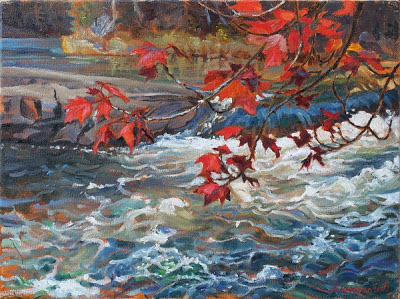On The Road (oil on canvas 5 x 7 in.) SOLD!
15 May finds us on Highway 101, north of Temiskaming, Quebec. Fred has just marked the waypoint # 248 on the GPS, and Adam glances at me in the rear view mirror. I am actually doing this painting in the back seat as we drive, knowing that there will be no time to stop to paint today - we're on our way home. I have to raise my brush when the road gets too bumpy, but for the most part I've developed a technique of bracing the corner of the canvas on my lap board and one of the fingers of my painting hand on the edge of the canvas while holding the back of the stretcher firmly with my left hand - and applying paint between the bumps! I am referring both to the real scene and to a photo I've downloaded to my laptop.
We have been making regular stops, however, to take specimens and mark the locations of stands of the tall reed Phragmites whenever we see them along the roadsides. Fred hits the "mark" button, Adam stops the van, Fred gets out to collect a sample and Adam follows him with the camera while I write the habitat description. Most of them appear to be the native type, with dark reddish nodes or joints along a smooth stem and a smaller, thinner banner of seed "glumes" than the rough stemmed invasive kind. Some day the natives may be recognized as separate species, but for now they are all called Phragmites australis. Despite the invasive having been in Canada for over 100 years they are only considered subspecies although they don't seem to hybridize. When we went west in 2000 before the difference between the natives and the invasives was formally recognized we saw differences among the natives which may require taxonomic recognition, and it's going to be one of the goals of our summer travels to gather specimens so this situation can be studied.
There is no Phragmites in my scene - just a pleasantly curving, ordinary-looking stretch of road. It was exciting to pass from the clay belt onto the shield. The first sign of that were peoples' houses. Some were built with round granite stones shaped by the glaciers, and some with flat broken pieces. As I was still wondering where they had brought the stones from we passed over a height of land and there were granite outcroppings and erratics by the roadside. More than enough rock for everyones' houses!
It was also exciting as we came far enough south for the Sugar Maples to survive and saw hillsides pink and fluffy with flowers and young leaves. I haven't yet painted them, but their stout trunks and gnarly character made them worthy subjects for the Group of Seven.
We have been making regular stops, however, to take specimens and mark the locations of stands of the tall reed Phragmites whenever we see them along the roadsides. Fred hits the "mark" button, Adam stops the van, Fred gets out to collect a sample and Adam follows him with the camera while I write the habitat description. Most of them appear to be the native type, with dark reddish nodes or joints along a smooth stem and a smaller, thinner banner of seed "glumes" than the rough stemmed invasive kind. Some day the natives may be recognized as separate species, but for now they are all called Phragmites australis. Despite the invasive having been in Canada for over 100 years they are only considered subspecies although they don't seem to hybridize. When we went west in 2000 before the difference between the natives and the invasives was formally recognized we saw differences among the natives which may require taxonomic recognition, and it's going to be one of the goals of our summer travels to gather specimens so this situation can be studied.
There is no Phragmites in my scene - just a pleasantly curving, ordinary-looking stretch of road. It was exciting to pass from the clay belt onto the shield. The first sign of that were peoples' houses. Some were built with round granite stones shaped by the glaciers, and some with flat broken pieces. As I was still wondering where they had brought the stones from we passed over a height of land and there were granite outcroppings and erratics by the roadside. More than enough rock for everyones' houses!
It was also exciting as we came far enough south for the Sugar Maples to survive and saw hillsides pink and fluffy with flowers and young leaves. I haven't yet painted them, but their stout trunks and gnarly character made them worthy subjects for the Group of Seven.




Actually I'm shown as rather more tranquil than I would have been at that point in the trip. I knew from reviewing previous records that there was a great density of stands of the native-type Phragmites on that stretch of highway, north of Riv. Gordon, and I was waypointing and writing notes on more than one stand per minute all along there. On this trip we got a continuous record of Phragmites stands from Opasatika, west of Kapuscasing, to Burritts Rapids, on the banks of the Rideau, so we'll be able to compare the status of the native and invasive forms now with waht it was in the 1990s and 2000.
ReplyDelete